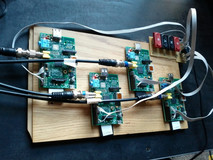Cheap 4-channel Videoplayer
For the dance piece Ich(a) by Zufit Simon I constructed a system with four Raspberry Pi mini-computers and buttons to trigger playback of four video streams. As the videos didn't need to run in exact frame-by-frame sync, this was a very cheap way to get four channel high-quality video playback. Total cost was about (RPi 28 * 4) + (SD card 6 * 4) + (5V power 1 * 7) ≈ 141 Euro. I chose the model A of the Raspberry Pi to keep the cost and power consumption down. The four computers share a 5V power supply of 2 amps and are powered over the GPIO pins. Video cables run 50 meters down to the stage and into separate flat-screen monitors. The monitors are built into boxes that can be piled up or rolled around independently.
The videos are stored on the 4 GB SD cards that also holds the Linux operating system. I converted the videos from DVD to MP4 using ffmpeg with the following settings...
ffmpeg -i concat:"/Volumes/MONITOR01_may2012_DVD/VIDEO_TS/VTS_01_1.VOB|/Volumes/MONITOR01_may2012_DVD/VIDEO_TS/VTS_01_2.VOB" -an -vcodec libx264 -profile:v high -preset fast -crf 18 -b-pyramid none -f mp4 MONITOR01_may2012.mp4
That'll take two chapters and convert to a single MP4 and skip the audio track (-an flag).
The Python program running on each computer is here below. It plays a video to the end and waits for a button trigger. If a button is pressed before the video is finished, it'll stop and jump to the next video - all in a cyclic fashion.
#f0videoplayer.py
#for a Raspberry Pi running Raspbian
#this script will cycle through videos in sequence when a GPIO pin is grounded
#pinSwi (pulled up internally) - GND this pin to switch to the next video
#pinOff (pulled up internally) - GND this to shut down the system
#--settings
videos= ['/home/pi/ICHA1.mp4', '/home/pi/MONITOR01_may2012.mp4', '/home/pi/BLACK.mp4', '/home/pi/FLESH.mp4', '/home/pi/TESTBILDER.mp4']
delays= [0, 0, 0, 0, 0] #extra start delay time in seconds - one value for each video
pinSwi= 23
pinOff= 24
#--
import pexpect
from time import sleep
import RPi.GPIO as GPIO
import os
GPIO.setmode(GPIO.BCM)
GPIO.setup(pinSwi, GPIO.IN, pull_up_down= GPIO.PUD_UP)
GPIO.setup(pinOff, GPIO.IN, pull_up_down= GPIO.PUD_UP)
def main():
os.system("clear && tput civis") #clear and hide cursor
index= 0 #keeps track of which video to play
while True:
sleep(delays[index])
omx= pexpect.spawn('/usr/bin/omxplayer -rp '+videos[index])
omx.expect('Video') #play
while(GPIO.input(pinSwi)==True):
sleep(0.1)
if GPIO.input(pinOff)==False:
omx.send('q') #quit
os.system("tput cnorm && sudo halt")
exit()
omx.send('q') #quit
sleep(0.5) #safety
while(GPIO.input(pinSwi)==False):
sleep(0.01)
index= (index+1)%len(videos)
if __name__ == "__main__":
main()
Instructions for installing
(you'll need a model B to prepare an SD card, but then move it over to the model A Raspberry Pi)
prepare the RPi
- use Pi Filler to transfer 2013-05-25-wheezy-raspbian.img to the SD card
- put the SD card in RPi model B
- select 'Expand Filesystem' in and enable SSH under advanced in config menu
- select 'Finish' and reboot
- log in with pi/raspberry
sudo apt-get updatesudo apt-get upgradesudo apt-get install python-pexpect avahi-daemon
copy files from macOS
- open a terminal window on the main computer
- cd to folder with videos
- edit the file f0videoplayer.py and select which videos to use
- optionally add delay times if some videos should start later
scp f0videoplayer.py MONITOR01_may2012.mp4 ICHA1.mp4 BLACK.mp4 FLESH.mp4 TESTBILDER.mp4 pi@raspberrypi.local:/home/pi/
back to model B
sudo pico /etc/rc.local- add the following before the exit line:
(sleep 1; python /home/pi/f0videoplayer.py) & # autostart video player - press ctrl+o to save and ctrl+x to exit
sudo halt
start model A
- take out the SD card from model B and put it in model A
- connect HDMI or composite video, GPIO pins and apply power - the first video should start
- ground pin 23 to cycle through the videos
- ground pin 24 to turn off the computer
Useful commands
(connect a keyboard to RPi model A, type pi/raspberry to log in)
sudo pkill omxplayer.bin #might need to write this without the terminal being visible
if you get "WARNING: REMOTE HOST IDENTIFICATION HAS CHANGED!"
ssh-keygen -R raspberrypi.local #useful for resetting ssh/scp after changing SD cards
It's not pretty but it's working. Some day I'll build it into a real rackmount box.
References
www.raspberrypi-spy.co.uk/2013/06/playing-videos-on-the-raspberry-pi-command-line

